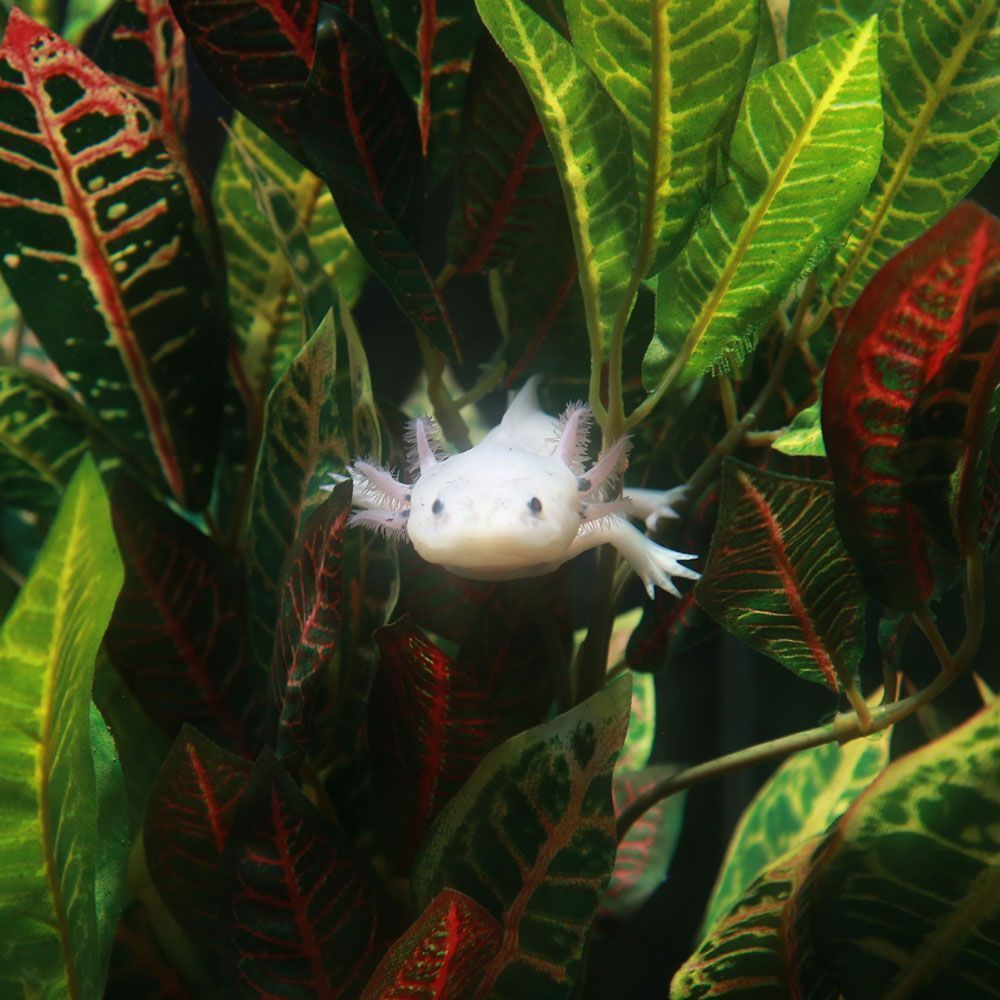With their everlasting cute smiling face and active yet shy personality, these unique creatures make for delightful companions.
The best part? They are extremely non-demanding pets with a simple diet and robust nature. All you need to have is the right aquatic setup.
Intriguing right? So, now, let’s dive into the world of these quirky buddies.
What is an Axolotl?
Axolotls are one-of-a-kind aquatic creatures. These freshwater salamanders capture the hearts of fish and amphibian enthusiasts worldwide. Lets take a look at their characteristics below:
| Origin | New Mexico, Lake Xochimilco, Lake Chalco |
| Order | Caudata |
| Family | Ambystomatidae |
| Scientific Name | Ambystoma mexicanum |
| Common Names | Axolotl, Mexican walking fish, Mexican salamander |
| IUCN Red List Status | Critically Endangered |
| Appearance | Wide heads, small, round, lidless eyes. In wild: black with greenish mottling or grayish brown or tan with gold speckles and silvery highlights. |
| Size | Usually 15-45 cm (6-18 in). Rarely over 30 cm (12 in) |
| Lifespan | Usually, 10 years, Max: up to 15 years or more with the best care |
| Temperament | Peaceful, solitary |
| Tank Level | Bottom-dweller |
| Water Temperature | 60-70 °F (15-21 °C) |
| pH Level | 7.4-7.6 |
| Water Hardness | 7-14 dGH |
| Care Level | Beginner/Easy |
| Minimum Tank Size | 30 gallons for one, 40 gallons for two. |
| Tank Environment | Plenty of hiding spaces, caves, pipes, plants, smooth sand, optional lighting, and gentle water flow |
| Diet | Carnivorous |
| Tank Mates | Peaceful, fast-moving fishes and invertebrates that are too large to fit into axolotl’s mouth |
What is the History of Axolotl?
The history of axolotls dates back to the Aztec civilization in Mexico, where they were sold as food.
In 1863, 34 axolotls were brought from Mexico to France for scientific studies on limb growth. Later, they became popular pets in Europe. Many captive-bred axolotls trace their ancestry back to this group.
Where did the name for Axolotl come from?
Axolotls were named after the ancient Aztec god of fire, lightning, deformities, and death, Xolotl. The god was believed to have transformed into an axolotl to escape being sacrificed to the sun by other gods. In the Nahua language, axolotl means water dog.
What is the Natural Habitat of Axolotl?
Axolotls were found in lakes of Mexico City, like Lake Xochimilco and Lake Chalco. Unfortunately, Lake Chalco was drained, so now they are only found in Lake Xochimilco.
The ideal temperature of Lake Xochimilco allows the creature to hide, crawl, and swim comfortably at the lake bottom.
Are Axolotl Endangered?
Axolotls are nearly extinct in the wild. As per the last evaluation in 2019, they were classified as Critically Endangered on The IUCN Red List. Scientists are working on their conservation, breeding captive ones, and planning reintroductions into clean waters for their survival.
What is the Reason behind the extinction of Axolotl?
Axolotls are threatened by poor water quality and the introduction of invasive species like carp, perch, and tilapia to their natural habitat. They compete with axolotls for food and hunt them down. Lots of inbreeding causes genetic challenges, pushing them near extinction.
How many Axolotl are left?
In the wild, about 50-1,000 axolotls exist. However, accurate counting is difficult due to their shyness towards humans. In captivity, their numbers thrive, potentially reaching 1 million, and they are popular as pets and lab subjects globally.
What family do Axolotl belong to?
The axolotl belongs to the Caudata order and Ambystomatidae family. Despite its aquatic lifestyle, it’s not a fish but an incredibly rare aquatic salamander.
Scientifically known as Ambystoma mexicanum, these are often called Mexican walking fish or Mexican salamander. The name Mexican walking fish comes from their underwater walking habit.
How does an Axolotl look?
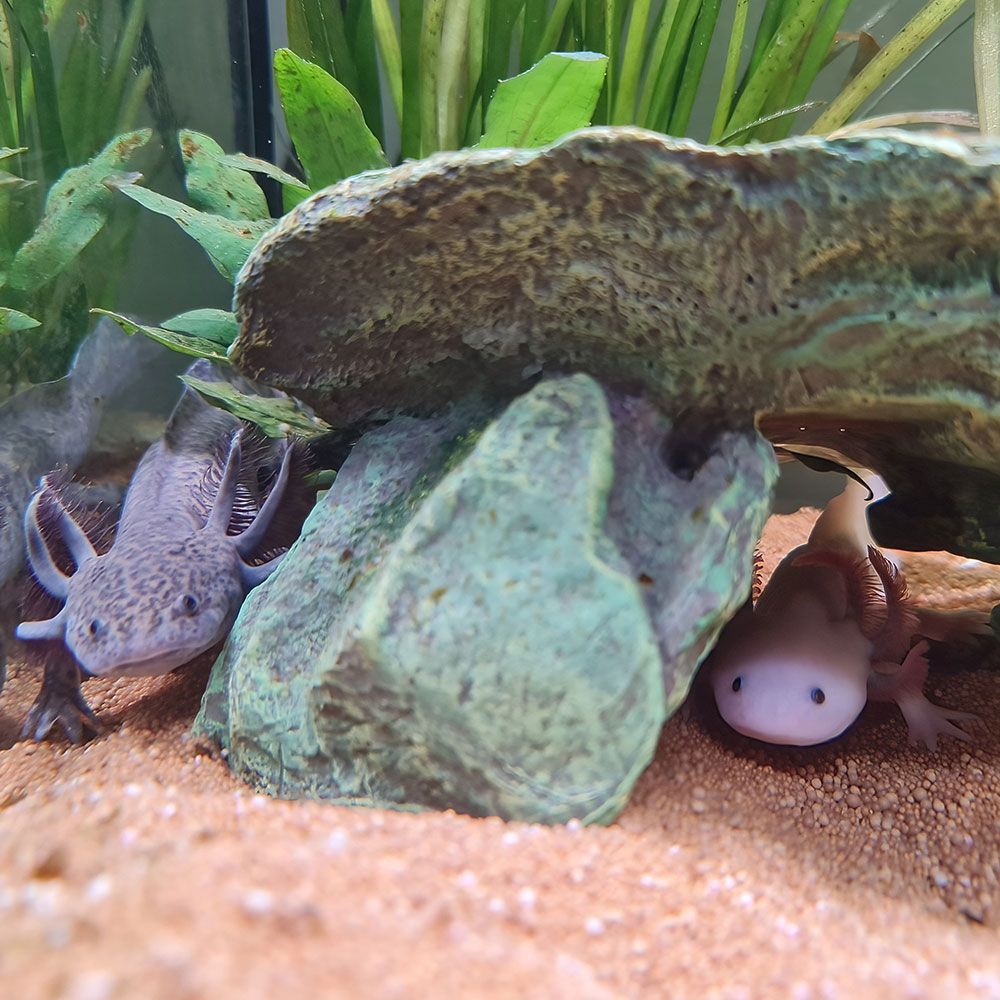
The axolotl looks like a combination of a fish and a reptile, more like a swimming lizard. Now, let us dive right into exploring the physical traits and behavior of axolotl.
What is the size of an Axolotl?
Adults, between 18 to 27 months old, typically measure 15 to 45 cm (6 to 18 in). The most common size is around 23 cm (9 in), while anything over 30 cm (12 in) is rare.
What is the Color of an Axolotl?
Axolotls have diverse colors due to mutations in four pigmentation genes.
In the wild, these commonly display black with greenish mottling or grayish brown or tan with gold speckles, some even with silvery highlights.
The dark-colored axolotls can shift their hue to various shades of light and dark colors to camouflage with the background.
Breeders create various axolotl color morphs, including double mutants. You can find mutations like leucistic, golden albino, grey xanthic, pink albino, piebald, all-black melanoid, mosaic, copper, and lavender. Some also have black-and-white patterns.
The most common types are albino, grey, and mottled white and black.
Rare breeds include yellow hypomelanistic, dark hypomelanistic, albino hypomelanistic, copper, black melanoid, white albino, speckled leucistic, chimera, heavily marked melanoid, green fluorescent protein (GFP), firefly, enigma and more.
How does the body of an Axolotl look?
Axolotls have cylinder-shaped bodies, wide heads, small, round eyes without lids, and yellow eyelids.
They have underdeveloped limbs with long, thin digits – four on the front foot and five on the back foot.
They have unique traits similar to salamander larvae, like external gills and a tail fin. Unlike other salamanders, they retain these gills due to neoteny, staying aquatic throughout their lives.
Adults have three pairs of external gill stalks with filaments for breathing. They appear as feathery appendages behind their heads. There are hidden gill slits lined with filters to prevent food entry.
How many Teeth do Axolotl have?
They have evolved from ancestors with functional teeth. Now, they have 30-40 barely visible smaller and vestigial teeth in each jaw. Their teeth don’t help in chewing but in grasping and holding prey and identifying different axolotl species and subspecies.
Scientists study these teeth for various research purposes.
Do Axolotl undergo Metamorphosis?
Unlike most amphibians, axolotls don’t undergo metamorphosis due to a lack of thyroid-stimulating hormone. So, they don’t develop lungs and legs and can’t adapt to life on land. However, artificial metamorphosis induction via hormone injections is possible.
What is the difference between a male and a female Axolotl?
Males can be sexually distinguished by their longer and less rounded bodies. Mature males also have a longer tail and a swollen cloaca lined with papillae. Females have plump and often shorter bodies.
How do Axolotl behave?
Axolotls are solitary, calm, gentle, and naturally curious. They are often found exploring their environment and interacting with surrounding objects.
Primarily nocturnal, i.e., they are most active at night, displaying natural behaviors like hunting and burrowing under substrate. Each axolotl has a unique personality, with some being more outgoing than others.
Although they don’t bond with their owners, they recognize them to some extent. They can also be trained to interact with owners.
What is the Lifespan of an Axolotl?
Axolotls typically live around 10 years on average. There are also instances of them thriving for 15 years or even more.
Interesting Facts about Axolotl
Here are a few unique facts about Axolotls:
- These have extraordinary regenerative powers, capable of regrowing lost limbs (up to 5 times), tails, parts of their eyes, gills, and even parts of their brains.
- Their hearts are often used to understand the human heart better.
- Scientists often find it difficult to decode axolotl’s complex genome, which is 10 times larger than a human’s. Studying their genes helps scientists understand how axolotls use stem cells for regeneration.
- They are known to breathe through their skin, although they have gills. This makes them excessively sensitive to water quality.
- The creature is almost a thousand times more cancer-resistant than other mammals.
Author’s Note: Avoid touching axolotls directly, as it is harmful to their delicate, soft bodies and permeable skin. If necessary, use a soft mesh net to handle them gently.
How to Take Care of Axolotl?
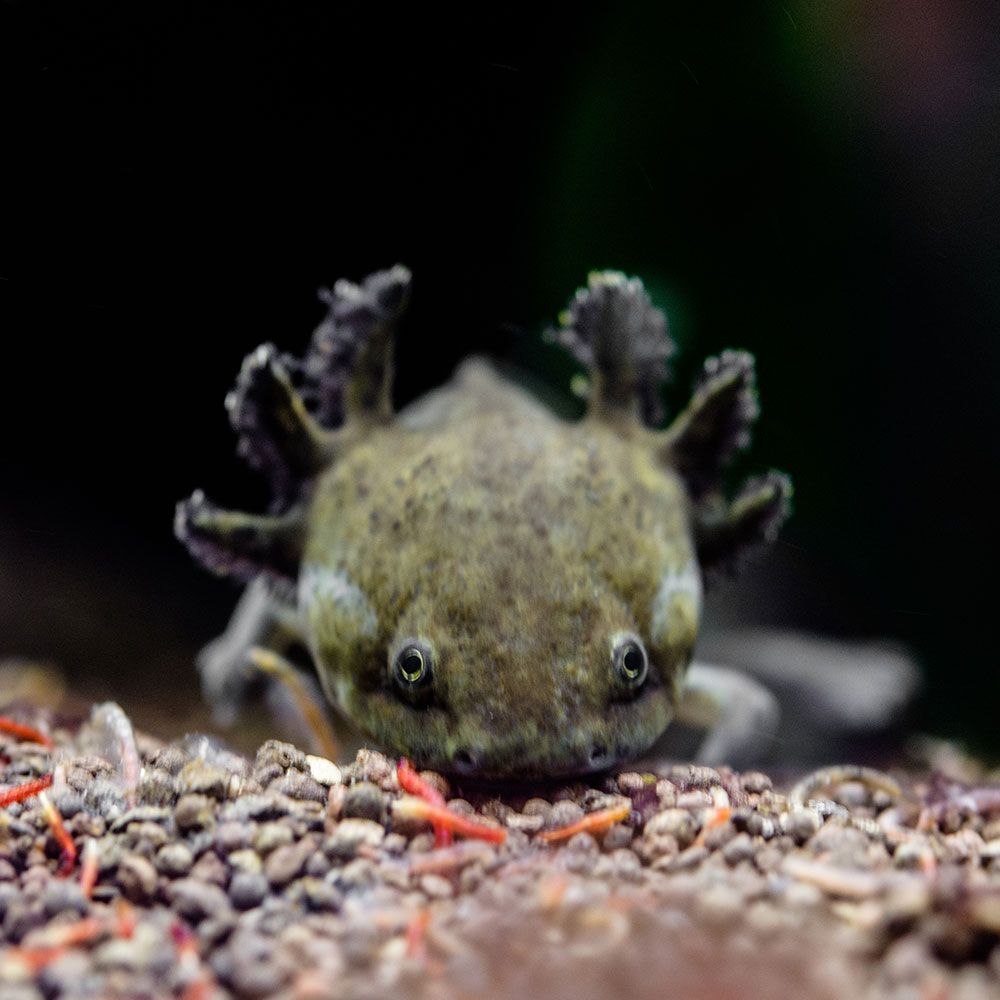
Even though axolotls are mole salamanders, caring for them differs significantly from most other salamanders. Remember, don’t pull them out of the water if not necessary. They can only survive up to one hour on land, given it’s a damp and moist environment.
With that, if you’re ready to bring this amphibian into your home, let us start creating its new habitat right here!
What is the recommended Tank Size for Axolotl?
You need at least a 30-gallon tank to house one axolotl comfortably and help it thrive. A larger 40-gallon tank is highly recommended if you keep more than one.
What is the Water Chemistry for Axolotl?
The natural habitat of these water-sensitive creatures has slightly saline freshwater, aka brackish water. Some experts suggest brackish water for pet axolotls, but they can also live in properly treated freshwater with the right pH and hardness.
To help your pet axolotls live their best lives, you should maintain these standards.
- pH Levels: 7.4-7.6
- Water Temperature: 60-70 °F (15-21 °C)
- Water Hardness: 7-14 dGH
- Ammonia: 0 ppm
- Nitrite: 0 ppm
- Nitrate: Below 10 ppm
- Salinity: Salt is not necessary. They can tolerate 20-40% Holtfreter’s or John’s solutions and up to 15 g/L salt briefly.
What is the Tank Environment for Axolotl?
How you arrange your tank can significantly impact your axolot’s mood and overall health. Let us create the best environment for them!
Should you use Substrate for Axolotl?
Axolotls may ingest the substrate while eating, leading to health issues. So, avoid gravel and instead choose sand with smooth particles under 1mm in size. They enjoy digging and playing in the sand. So, this enhances their well-being and prevents distress.
Should you have Plants with Axolotl?
They love digging and uprooting live plants. They might also nibble the leaves. Plants are a great snack for them
Further, they are sensitive to light due to their lidless eyes. So, you must include plants that survive in low light and cold water, such as:
- Anubias
- Elodea
- Java moss
- Marimo algae balls
- Hornwort
- Pothos
- Water lily
- Banana lily
- Pennywort
- Amazon swords
- Brazilian waterweed
- Water sprite
- Floating crystalwort
- Fern-leaf swampweed
- Cryptocoryne wendtii
- Java fern
- Duckweed
- Frogbit
- Water lettuce
- Water wisteria
Avoid adding chemicals for plant maintenance, as axolots absorb them with their semi-permeable skin.
What Lighting should you have in an aquarium with Axolotl?
Axolotls don’t have strict lighting requirements and are sensitive to sudden changes in lighting. It’s better to avoid any lighting in your tank. The lighting of your room where the tank is placed is plenty for them.
If you have plants, use a plant-friendly LED light with adjustable brightness to keep them stress-free and also ensure plant health.
What type of Décor should you have for Axolotl tank?
Include caves, PVC pipes, and custom rock hide in your axolotl tank, as these creatures enjoy hiding spots. Some other decor options are mesh reptile hammocks, moss balls, driftwood, and big rocks.
Always ensure that the decor items don’t have sharp edges, as that can hurt their sensitive skin.
What filter should you choose for Axolotl tank?
When choosing a filter for your axolotl tank, opt for one with multiple media baskets to accommodate enough biomedia, essential for processing waste and maintaining water quality. Canister filters are highly recommended.
Aim for a filter with a GPH (gallons per hour) approximately four times your tank’s capacity for optimal performance. However, you must be aware to prevent over-filtration as it might stress them.
What is the Water Flow Rate for Axolotl?
Ensure the filter has a gentle water flow, preferably using a spray bar, to prevent stress on your sensitive axolotls.
The ideal flow rate for the tank is 3-6 times its tank size. For instance, for a 40-gallon tank, a 120 GPH flow is ideal.
Care Tip: Ensure that the tank is placed in a quiet, vibration-free area. Axolotls are sensitive creatures, and excessive noise or vibrations can stress them out.
What do Axolotl eat?
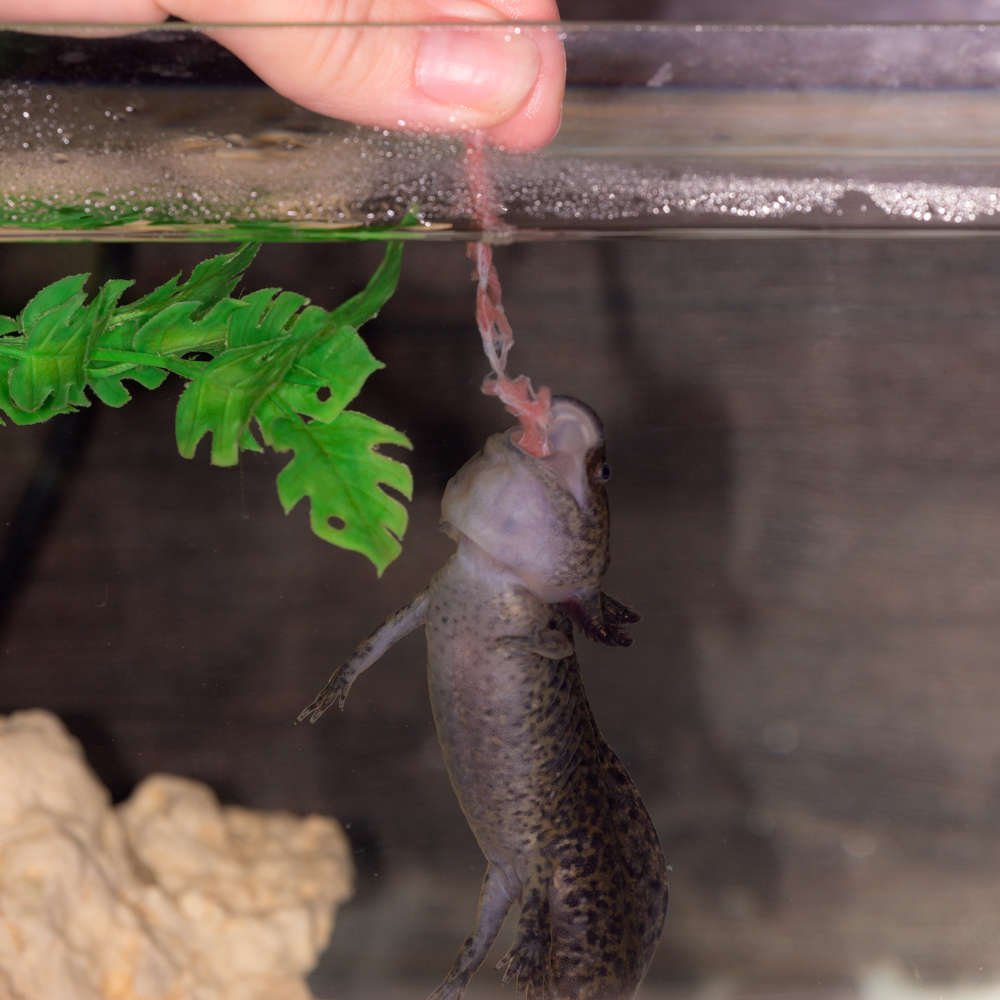
In the wild, axolotls are carnivorous, feeding on worms, insects, small fish, and anything that fits into their mouths and swallow whole.
They find food using their sense of smell and swiftly capture potential meals by snapping at them, utilizing a vacuum-like force to draw the food into their stomachs.
As a pet owner, you can provide a balanced diet by offering a variety of live and dead foods, like:
- Trout pellets
- Salmon pellets
- Waxworms
- Blackworms
- Earthworms
- Bloodworms
- Frozen brine shrimp
- Whiteworms
- Daphnia
- Axolotl pellets
- Repashy grub pies
- Live nightcrawlers
- Mysis shrimp
- Red wigglers
- Small bits of raw, lean beef heart
Though they can also be fed feeder fish, it’s better to avoid it as they might be harmful. Further, dust the feed with a calcium supplement and practice gut loading.
Feed it according to its age and individual appetite. Offer food slowly until it stops eating, which only happens when it is full.
For larvae and juniors, feed twice daily; for adults, feed once every 2-3 days. Healthy adults can fast for up to 2 weeks and remove uneaten food promptly.
Feeding Tips
- These are attracted to the movement of live prey. When feeding dead prey, use long tongs to wiggle the food to entice them.
- Hand-feeding axolotls fosters social behavior; their teeth can latch on to but can’t pierce human skin.
- Feeding in a separate tank can prevent water contamination but is not necessary.
Which Tank Mates are recommended with Axolotl?
Axolotls prefer isolation and are best kept alone. They are carnivores but typically don’t harm other fish due to their slow nature.
When choosing tank mates, opt for peaceful critters that can’t fit in an axolotl’s mouth and are fast enough to escape, as axolotls may attempt to hunt or tease them.
Keep in mind that they need cool water, so choose companions adapted to low temperatures.
Some of the ideal tank mates for them include:
- Barbs: Rosy, checkered, golden, Indian glass, maharaja, red-line torpedo, golden dwarf, Odessa, shalyni, two-spotted, clown, glass, greenstripe, onespot, spotted and swamp
- Danio Fish: Zebrafish, pearl, orange-finned, Bengal, northern glowlight, moustached, peninsular, rosy, black-barred, blue, blue moon, Hikari, dwarf spotted and gold ring
- Guppies, Endler’s livebearers, green swordtails, dusky millions fish, mosquito fish
- White cloud mountain minnows, Dojo loaches, Inle loaches
- Japanese rice fish
- Cardinal tetra
- Golden skiffia
- Frail gouramis
- Giant Chinese bitterlings
- Playfair’s panchax
- Red-spotted panchax
- Scarlet badis
- Rainbow characodon
- Small shrimps
- Apple snails
If you want an axolotl-only tank, you can keep adult males and females together. But if you don’t want to breed them, you can keep two males together.
Avoid mixing axolotls of different sizes or ages, as they can display cannibalistic behavior. If issues arise, separate them.
What Tank Mates to Avoid for Axolotl?
Avoid housing them with:
- Tropical fish: Axolotls prefer cool water, making tropical fish unsuitable companions.
- Territorial and aggressive fish: Peaceful axolotls can be harassed or injured by them.
- Highly active swimmers: Their constant movements might stress out axolotls.
- Sharp-spined fish (e.g.: cory catfish): They can harm axolotls if attempted to be eaten.
- Small fish and mini snails: They might pose choking hazards and carry diseases that can affect axolotls.
- Other bottom-dwelling fish or fast-eating tank mates: These create direct competition for food as axolotls eat slowly and cannot compete with them; they may end up being underfed in their presence.
What are the Common Diseases for Axolotl?
Though these creatures have marvelous regenerative abilities, they might be susceptible to various ailments. Besides keeping their tank clean and providing a healthy environment, keep an eye out for the following:
| Disease Name | Causes | Symptoms | Treatment |
|---|---|---|---|
| Fluid Disorders, Genetic and Nutritional Problems | Genetic abnormalities, heart damage, kidney problems, nutritional deficiencies. | Fluid build-up (edema and ascites), abnormal cell growth (tumors), loss of appetite, deterioration of gills. | Consult a vet for drainage. Change the diet. Keep them in clean, cool water, Holtfreter’s solution or salt baths, avoid fatty foods, and crush mealworms before feeding. |
| Parasites | Infected bait containing parasitic protozoa | Excess skin mucus, external flatworms attaching to the skin, appetite loss | Metronidazole for enteric protozoans, salt baths, formalin for ectoparasites. |
| Wounds and Physical Damage | Physical injuries, loss of gill or limb, fin damage. | Visible wounds, potential infection. | Keep them in clean, cool water. Use Holtfreter’s solution or salt solution. |
| Stress | Bad water parameters, overcrowded tank, aggressive tank mates, strong water flow. | Poor response, anemia, skin lesions, lack of appetite, gill degeneration. | Improve water quality, avoid overcrowding, keep them alone, and reduce water flow. |
| Ammonia Poisoning | Uncycled tank, overfeeding, presence of uneaten food and waste. | Curling and whitening of gill filaments, poor appetite, lethargy, hemorrhage, death. | Regular testing, water changes, ammonia neutralizers, restrict feedings. |
| Hyperthermia | High temperatures, prolonged hot spells. | Lack of appetite, uncontrollable floating, ascites. | Antibiotic therapy, cooling methods (refrigerator, chillers) |
| Gastric and Intestinal Foreign Bodies | Ingestion of substrates, swallowing smaller tank mates. | Floating, poor appetite, frantic swimming, cuts in the mouth. | Regurgitation (in acute cases), removal under anesthesia. |
| Bacterial Infection | Poor water quality, unsterile plants, infected live food. | Reduced appetite, red patches on body, fin rot, tail rot, ulcers, scale shedding. | Calcium/sodium hypochlorite solution, antibiotics via injection. |
| Fungus Infection (Saprolegnia) | Poor water quality, high temperatures, compromised immune system. | White and fuzzy patches on the body, loss of gill stalks. | Salt baths, isolation, potassium permanganate, address underlying stress factors. |
| Tumor | Various factors | Growths on the body | Removal by a vet if causing issues. |
Quick Tip: Bowel obstructions are a common cause of death of axolotls. To prevent that, avoid putting items smaller than 3 cm (the size of an axolotl’s head) in their tank.
What are the Breeding & Reproduction Patterns for Axolotl?
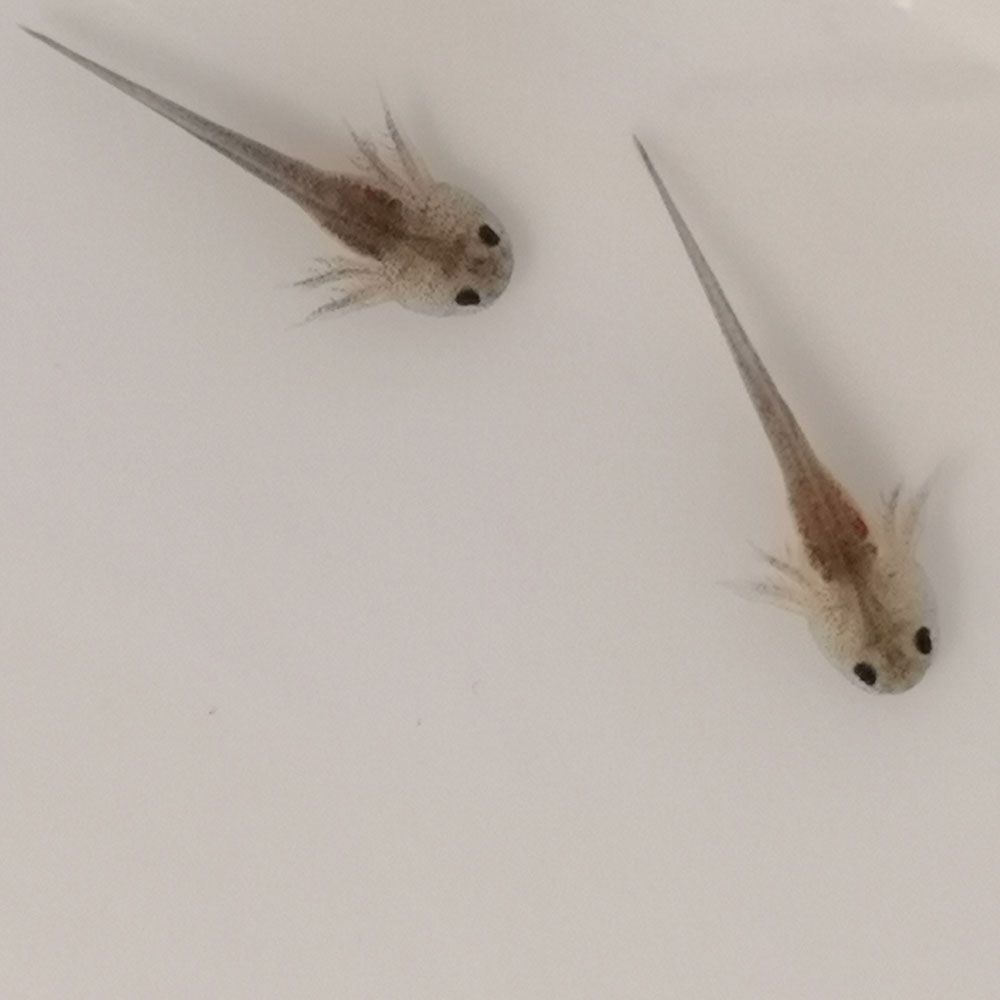
Axolotls have unpredictable breeding patterns influenced by temperature and day length. Breeding them also require careful consideration of their age, environment, and natural behaviors, ensuring the health of both parents and offspring.
Here are a few things you must follow to reproduce healthy ones.
How to select the Specimens of Axolotl?
Axolotls can reach sexual maturity between 5 months and a few years.
But in my experience, it’s advisable not to breed them before they reach 18 months of age. This lets the salamander grow up to its full potential. Breeding too early can be detrimental to young axolotls.
How many eggs do female Axolotl lay?
Female Axolotl can lay over 1,000 eggs. And since females mate several times a year, their body focuses all energy on egg production and not growth. This deeply impacts her body and health. This is another reason to delay the breeding process.
What does the Breeding Tank Setup for Axolotl look like?
Prepare a 40-gallon breeding tank for a pair. Provide silk or live plants for the female to attach her eggs and rough stones or slate for the male to deposit spermatophores.
What are the Breeding Seasons & Conditions for Axolotl?
Breeding can occur year-round, but optimal conditions are observed between December and June.
To trigger courtship behavior, replicate natural light changes or sudden temperature shifts, typically around 12-14 °C (54-57 °F). Even partial seasonal changes in a room can stimulate breeding.
What is the Mating Behavior of Axolotl?
The male axolotl initiates spawning with writhing motions and nudges on the female’s back.
If receptive, he leads her around, depositing spermatophores (packets of sperm) around the tank. These are then picked up by the female’s cloaca. Thus, fertilization occurs internally.
When does Female Axolotl Lay Eggs?
She lays eggs individually 12-72 hours after mating – on plants or various surfaces, with one spawn ranging from 100-1500 eggs. Eggs from the albino morph mother appear white, while other axolotl eggs are dark brown.
Once you spot the eggs, remove them from the tank promptly. Otherwise, these might consume their own eggs.
Keep the eggs well-aerated, which can be facilitated with an air pump. Special care should be taken with water conditions, ensuring it’s dechlorinated and at the right temperature (between 64-77 °F or 18-25°C) for successful hatching.
When do Axolotl Eggs Hatch?
Eggs hatch within 15 days around 77 °F. Newly hatched axolotls absorb yolk initially and then require live foods after 48 hours of birth. They only respond to food that moves. Suitable options include newly hatched brine shrimp, small daphnia, moina, and microworms.
How do Baby Axolotls grow?
As the larvae grow into juveniles, they grow their front legs first, unlike frogs. During this phase, they start accepting non-living foods. You can transition from live food to axolotl pellets diet. Make sure the transition in the diet is gradual.
Juveniles can also be fed small pieces of earthworms. Proper nutrition and attention to their growth ensure healthy development into adults.
Feed them 1-2 times a day as they’re pretty cannibalistic during this phase. This ensures their proper nutrition and healthy growth.
Once hind legs develop, young ones can be cared for, similarly to adults. Cannibalistic tendencies decrease with growth.
How to Maintain Water Quality for Axolotl?
Good water quality is essential throughout the axolotl’s growth stages. Monitor regularly, especially during the initial weeks, to ensure their well-being.
Breeding Tips
- Well-fed axolotl babies don’t form gas bubbles in the gut. But if your pet does, quarantine it in a separate container and feed it with forceps for 1-2 days until it purges the bubbles.
- Don’t overpopulate the baby axolotl tank to prevent the babies from losing limbs and damaging fins.
How to buy Axolotl?
If you want to keep them as pets, you should keep these in mind while buying them:
How to Check Legalities while buying Axolotl?
Verify the legality of owning an axolotl in your state. Familiarize yourself with exotic pet ownership laws in your area before making a purchase.
They are not allowed in California, Maine, New Jersey, and Virginia in the United States. Some states allow ownership but not importation.
How to choose a Healthy Axolotl while buying?
In the shop, when choosing axolotls, opt for juveniles with full, feathery gills and clear and undamaged skin. Ensure the it is eating normally and appears healthy and lively.
Reputable Sellers
Buy from reputable breeders or pet stores to ensure the health and authenticity. Ask for references or read reviews if purchasing from private sellers.
How to Transport Axolotl?
Safely transport the axolotl in a secure container, ensuring a stable water temperature.
What is the Cost of Axolotl?
In 2023, affordable axolotls – usually the wild types – from pet stores typically cost between $30 and $80. The price varies based on species, age, and location, so consider shipping costs too.
The most expensive ones are usually the rare breeds like chimera, enigma, and piebald. They come in various colors and can be as expensive as $1,300-1,500.
A word from FishInAquarium
Axolotls are one of the most popular pets of all time owing to their adorable looks and ease of care.
With basic water, environment, and food care, these relatively low-maintenance creatures provide endless entertainment with their bold and curious behaviors.
Despite their unusual appearance, their engaging personalities make them truly lovable companions that stay with you for years.
They are available in multiple colors, patterns, and prices. So, whether you just want to try your hand at raising one or want a limited edition collectible variety, you won’t be disappointed!
If you’ve enjoyed learning about axolotls, consider sharing this think-piece with your fellow enthusiasts. However, if you have any questions or need further information, feel free to reach out via email.

